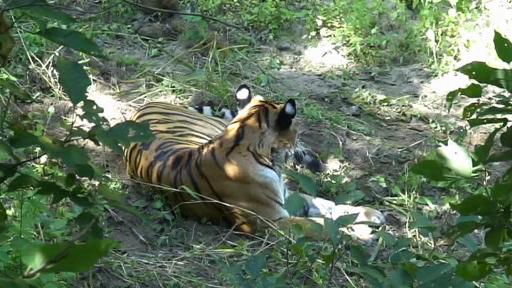At home in the jungle
An Indian living in the West, whose e-mails I have often posted at VFR (and who, by the way, is not an immigrant), sent me some nice photos he took in
Kanha National Park in the state of Madhya Pradesh in central India
when he was back home on vacation with some friends. From where he was sitting on top of an elephant, he snapped several shots of this tiger. While some of the shots, in which the tiger is facing the camera, are more dramatic, I especially like this one.

He writes: “It is a thick sal/bamboo forest spread over 1900 square kilometres. Kipling spent time in that forest and wrote The Jungle Book after he returned from there, if memory serves me correctly. There have been quite a few documentaries produced on Kanha. The most famous one is a BBC documentary by David Attenborough.”
He continues:
I first visited Kanha with my family when I was probably no more than four years old. I have been there more than ten times in all. A few things stand out. There is an old guest house in the middle of the Jungle where we stay. All other guest houses, lodges and tourist resorts are outside the Jungle and therefore not as enjoyable to stay in. That guest house gives some terrific views of the Jungle because you are basically living in the middle of the Forest. Also, the guest house was built in the colonial period and has resident cooks (referred to in Hindi as “Khaansama”—which means Government employed guest house cook) who prepare the best chicken curry served with piping hot “chapattis” that I have ever had anywhere in the world. And it is cheap too. Our last meal there we fed some seven people at the cost of $15.
For me it is an annual ritual whenever I go back home. Even though I have been there so many times before and I practically know even all the dirt roads inside the Jungle, it is still a special experience. You then realise that there are things on this earth that money cannot buy. The sheer rugged beauty of the untamed wilderness is something no man-made pleasures can ever match. At night after we have had a heavy meal, me and my friends usually arrange for a small bonfire to be made. We sit around it chatting away at night. And the sky looks absolutely incredible. I usually go back home in the Indian winter when it rains very very rarely. It has only rained once in the numerous trips I have made to Kanha. As a result, the sky is completely clear and the total absence of artificial lights means that one gets some of the most breathtaking views of the Universe. The weather is also amazing. On my trip in 2004, we visited the Jungle at the end of December which is peak winter in India. While India never gets terribly cold except in short spells, temperatures inside the Forest (which is on a considerable elevation as it is hilly) were zero degrees Centigrade at night. We would start our drive through the Jungle early morning at 5:30 a.m. and it would be absolutely freezing cold. I feel it even though I have now seen European winters. And then, amazingly, after sunrise, the temperatures climb to a cool, soothing 22 degrees Centigrade and stay that way until sunset when it starts to get cold very rapidly. The ride to the Park is also quite nice. There are thick forests and valleys on the way. And more than half the length of the route is covered with roads that aren’t particularly good—which adds a charm of its own. You see the odd village and then just open clear country or thick dense jungle before you approach the Park.
Here are more photos of Kanha from someone’s online gallery, found through Wikipedia.
I asked my correspondent if Kanha should be called a jungle or a forest, and he replied:
That’s a difficult one.
The word “Jungle” is actually from a Hindi word (pronounced “JUNGAL,” which means woodland or forest).
I suppose Jungle is more appropriate because it is a certain type of vegetation—essentially deciduous trees. It is different from a forest you’d find in North America and certainly very different from the tropical rain forests of South America, West Africa and South East Asia.
The main difference is that even though the vegetation is very thick, it only rains for four months of the year. During that time, conditions within the Jungle become similar to what you’d expect in a tropical rainforest—extremely wet with downpours sometimes lasting days.
But the rest of the year, the weather remains dry and crisp. It is cool in the winter and warm to hot in the summers.
Posted by Lawrence Auster at April 20, 2006 11:59 PM | Send
